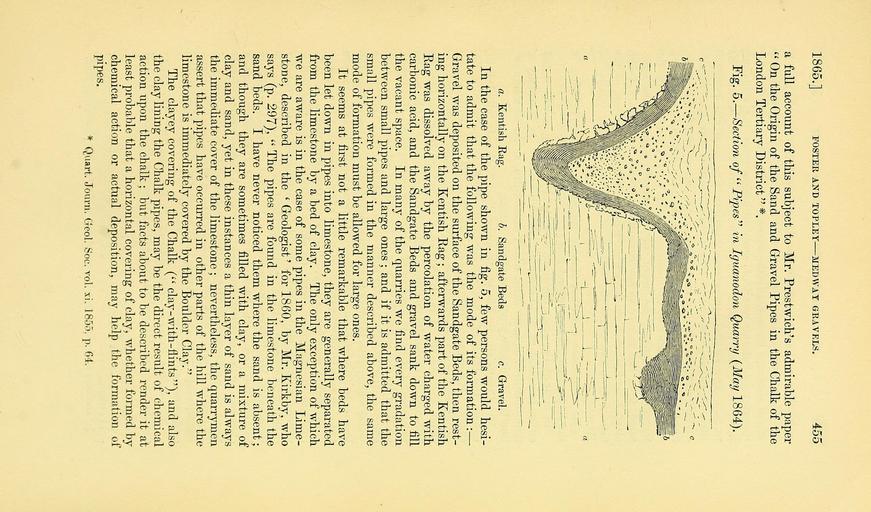MAKE A MEME
View Large Image

| View Original: | The_Quarterly_journal_of_the_Geological_Society_of_London_(12471641734).jpg (3200x1880) | |||
| Download: | Original | Medium | Small | Thumb |
| Courtesy of: | commons.wikimedia.org | More Like This | ||
| Keywords: The Quarterly journal of the Geological Society of London (12471641734).jpg 1865 <br> FOSTER AND TOPLEY MEDWAT GRAVELS <br> 455 <br> a full account of this subject to Mr Prestwicli's admirable paper <br> On the Origin of the Sand and Gravel Pipes in the Chalk of the <br> London Tertiary District <br> Fig 5 � Section of Pipes in Iguanodon Quarry May 1864 <br> a Kentish Eag b Sandgate Beds c Gravel <br> In the case of the pipe shown in fig 5 few persons would hesi- <br> tate to admit that the following was the mode of its formation � <br> Gravel was deposited on the surface of the Sandgate Beds then rest- <br> ing horizontally on the Kentish Eag ; afterwards part of the Kentish <br> Rag was dissolved away by the percolation of water charged with <br> carbonic acid and the Sandgate Beds and gravel sank down to fill <br> the vacant space In many of the quarries we find every gradation <br> between small pipes and large ones ; and if it is admitted that the <br> small pipes were formed in the manner described above the same <br> mode of formation must be allowed for large ones <br> It seems at first not a little remarkable that where beds have <br> been let down in pipes into limestone they are generally separated <br> from the Kmestone by a bed of clay The only exception of which <br> we are aware is in the case of some pipes in the Magnesian Lime- <br> stone described in the ' Geologist' for 1860 by Mr Kirkby who <br> says p 297 The pipes are found in the limestone beneath the <br> sand beds I have never noticed them where the sand is absent ; <br> and though they are sometimes filled with clay or a mixture of <br> clay and sand yet in these instances a thin layer of sand is always <br> the immediate cover of the limestone ; nevertheless the quarrymen <br> assert that pipes have occurred in other parts of the hill where the <br> limestone is immediately covered by the Boulder Clay <br> The clayey covering of the Chalk claj'-with-flints and also <br> the clay lining the Chalk pipes may be the direct result of chemical <br> action upon the chalk ; but facts about to be described render it at <br> least probable that a horizontal covering of clay whether formed by <br> chemical action or actual deposition may help the formation of <br> pipes <br> Quart Jouvti tcoI i oc rol xi IS' p Gi 34892133 108495 51125 Page 455 Text v 21 http //www biodiversitylibrary org/page/34892133 1865 Geological Society of London NameFound Iguanodon NameConfirmed Iguanodon EOLID 4530741 NameBankID 4204832 Biodiversity Heritage Library The Quarterly journal of the Geological Society of London v 21 1865 Geology Periodicals Smithsonian Libraries bhl page 34892133 dc identifier http //biodiversitylibrary org/page/34892133 smithsonian libraries Information field Flickr posted date ISOdate 2014-02-12 Check categories 2015 August 26 CC-BY-2 0 BioDivLibrary https //flickr com/photos/61021753 N02/12471641734 2015-08-27 09 54 36 cc-by-2 0 PD-old-70-1923 The Quarterly journal of the Geological Society of London 1865 Photos uploaded from Flickr by Fæ using a script | ||||